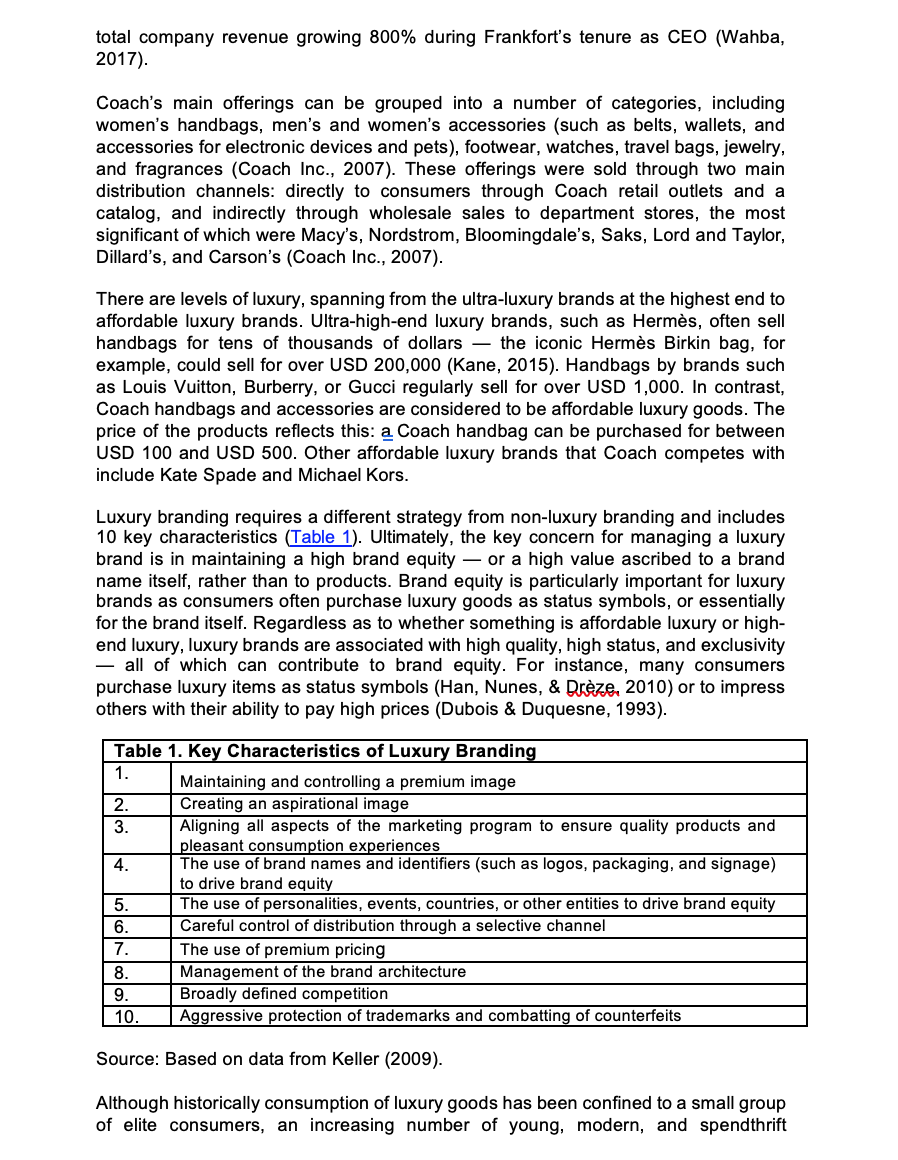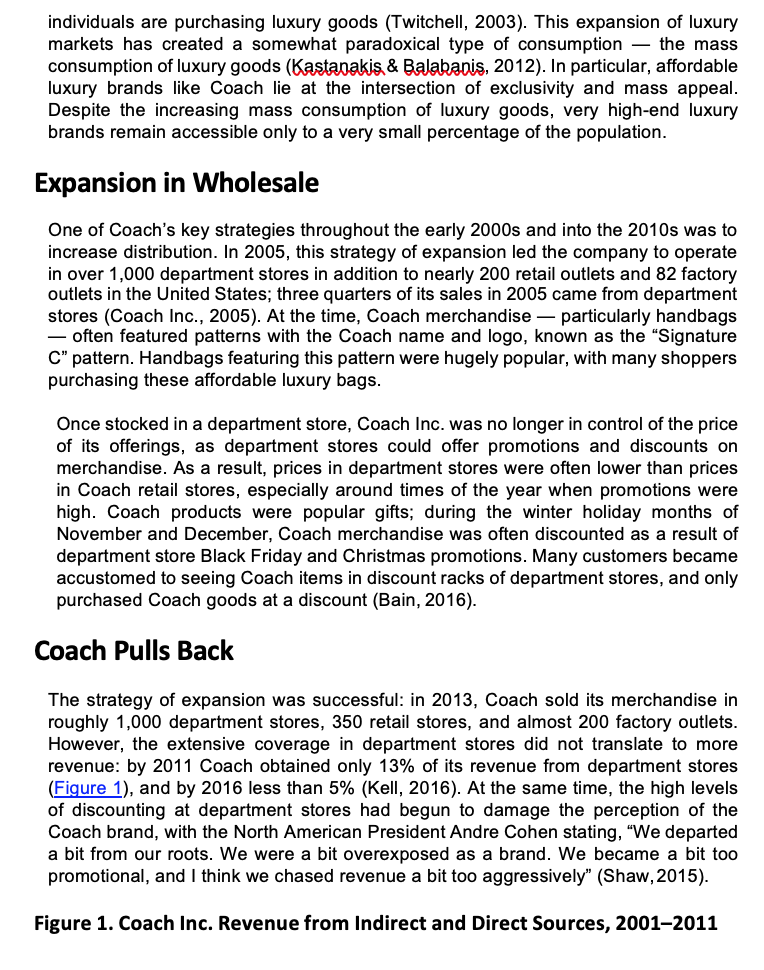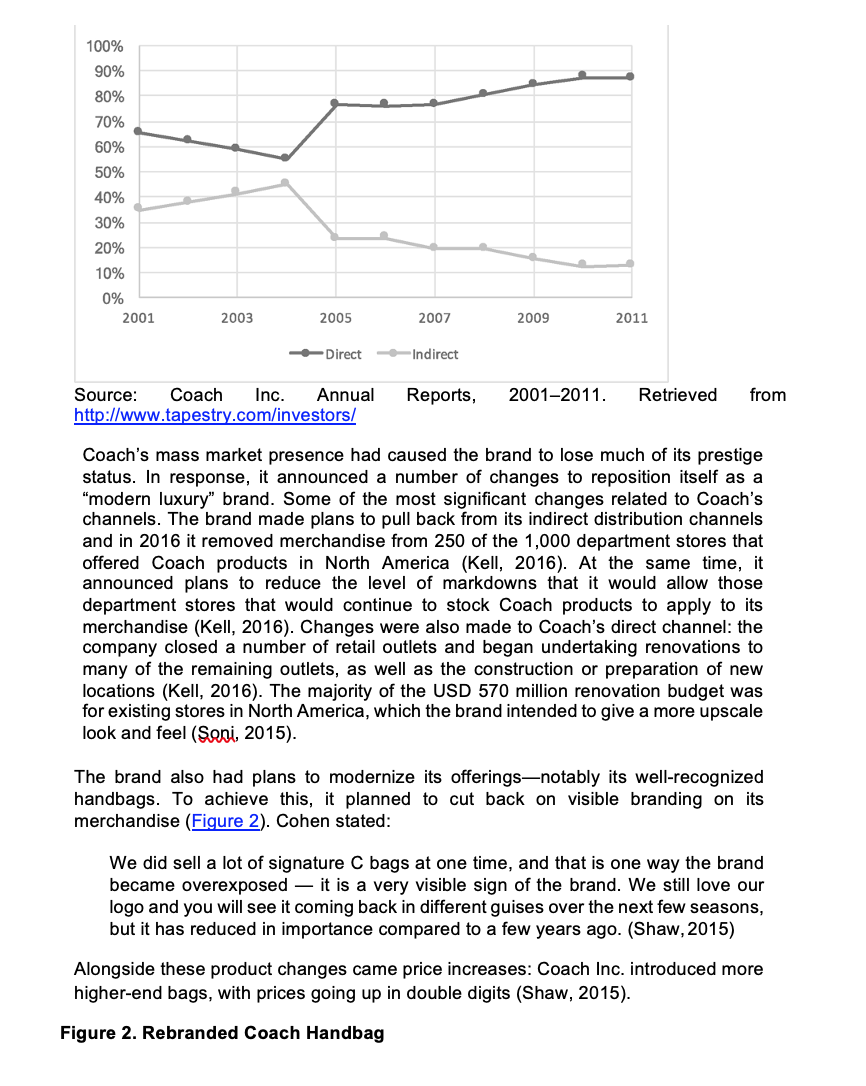Question 2
a)For the Australian, market used in Question 1, identify one potential market segment that Coach Inc. should target. Use your understanding of market segmentation theory and evidence from the case to substantiate your recommended target market.
b)For your potential market segment in Question 2a, create buyer persona describing the segment profile. Craft a positioning statement for the Coach Inc. brand that will tap into the segment's core values and maintain Coach Inc.'s repositioning as 'modern luxury'. Use evidence from the case to substantiate your recommended buyer persona and positioning statement where applicable.
Question 3
For your market segment/buyer persona from Question 2, recommend marketing mix (4Ps) strategies that implement your positioning statement. Include the main outcomes/objectives expected and at least one metric for measuring each strategy. Compare and contrast your recommendations with your brief evaluation of Coach Inc.'s marketing mix strategies since 2016. Justify your recommendations with relevant marketing theories.
Overexposure of a Luxury Brand: Coach Inc.'s Distribution and Image Problem By Matthew Wilson & Karen Robson January 02, 2019 Abstract Coach Inc. is a luxury fashion brand, primarily known for its women's handbags. Through the 2000s and early 2010s. the brand pursued a strategy of expansion, leading to its merchandise being available in many locations particularly in department stores. In 2014, the brand announced plans to reduce its distribution, citing concerns related to department store discounting of its merchandise and a related drop in brand status. In addition to cutting back on distribution, the brand renovated its own retail outlets, made changes to its products, and entered into a partnership with popular singer Selena Gomez. In response. sales of handbags in the price bracket of USD 400 or higher were up. as was perception of the Coach brand itself. Case Coach Inc.: Affordable Luxury Coach Inc. is a US. luxury brand primarily known for men's and women's handbags. The company was founded in New York City in 1941 as a wholesale business selling small leather goods to department stores. The business remained a relatively small wholesale business until 1996, when the CEO at the time, Lew Frankfort. hired Reed Krakoff to lead the company's marketing efforts (Levy, 2011). Krakoff had previously worked for other fashion brands such as Ralph Lauren and Tommy Hilger, and had a vision for the brand. saying: 'When you needed a new bag, you might go to Coach. I wanted to change it to a want, not a need\" (Levy, 201 1 ). In the decades that followed, Coach grew into a massive, coveted brand for leather goods and accessories, with Page 2 of 9 total company revenue growing 800% during Frankfort's tenure as CEO (Wahba, 2017) Coach's main offerings can be grouped into a number of categories, including women's handbags, men's and women's accessories (such as belts, wallets, and accessories for electronic devices and pets), footwear, watches, travel bags, jewelry, and fragrances (Coach Inc., 2007). These offerings were sold through two main distribution channels: directly to consumers through Coach retail outlets and a catalog, and indirectly through wholesale sales to department stores, the most significant ofwhich were Macy's, Nordstrom, Bloomingdale's, Saks, Lord and Taylor, Dillard's, and Carson's (Coach Inc., 2007). There are levels of luxuryI spanning from the ultra-luxury brands at the highest end to affordable luxury brands. Ultra-high-end luxury brands, such as Hermes, often sell handbags for tens of thousands of dollars the iconic Hermes Birkin bag, for example, could sell for over USD 200,000 (Kane, 2015). Handbags by brands such as Louis Vuitton, Burberry, or Gucci regularly sell for over USD 1,000. In contrast, Coach handbags and accessories are considered to be affordable luxury goods. The price of the products reflects this: a Coach handbag can be purchased for between USD 100 and USD 500. Other affordable luxury brands that Coach competes with include Kate Spade and Michael Kors. Luxury branding requires a different strategy from non-luxury branding and includes 10 key characteristics (Table 1). Ultimately, the key concern for managing a luxury brand is in maintaining a high brand equity or a high value ascribed to a brand name itself, rather than to products. Brand equity is particularly important for luxury brands as consumers often purchase luxury goods as status symbols. or essentially for the brand itself. Regardless as to whether something is affordable luxury or high- end luxury, luxury brands are associated with high quality, high status, and exclusivity all of which can contribute to brand equity. For instance, many consumers purchase luxury items as status symbols (Han, Nunes, 8. 9m 2010) or to impress others with their ability to pay high prices (Dubois 8; Duquesne, 1993). Table 1. Ke Characteristics of Luxu Brandln_ Maintaining and controlling a premium image Creating an aspirational image Aligning all aspects of the marketing program to ensure quality products and - leasant consum . tion ex - eriences The use of brand names and identiers (such as logos, packaging. and signage) to drive brand equity The use of personalities, events, countries. or other entities to drive brand equity Careful control of distribution through a selective channel The use of premium pricing Management of the brand architecture Broadly dened competition . 3 ressive protection of trademarks and combattin of counterfeits Source: Based on data from Keller (2009). Although historically consumption of luxury goods has been conned to a small group of elite consumers, an increasing number of young, modern, and spendthrift individuals are purchasing luxury goods (Twitchell, 2003). This expansion of luxury markets has created a somewhat paradoxical type of consumption the mass consumption of luxury goods (W8. mm, 2012). In particular, affordable luxury brands like Coach lie at the intersection of exclusivity and mass appeal. Despite the increasing mass consumption of luxury goods. very high-end luxury brands remain accessible only to a very small percentage of the population. Expansion in Wholesale One of Coach's key strategies throughout the early 2000s and into the 2010s was to increase distribution. In 2005I this strategy of expansion led the company to operate in over 1 ,000 department stores in addition to nearly 200 retail outlets and 82 factory outlets in the United States; three quarters of its sales in 2005 came from department stores (Coach Inc., 2005). At the time, Coach merchandise particularly handbags often featured patterns with the Coach name and logo, known as the \"Signature C" pattern. Handbags featuring this pattern were hugely popular, with many shoppers purchasing these affordable luxury bags. Once stocked in a department store, Coach Inc. was no longer in control of the price of its offerings. as department stores could offer promotions and discounts on merchandise. As a result, prices in department stores were often lower than prices in Coach retail stores, especially around times of the year when promotions were high. Coach products were popular gifts: during the winter holiday months of November and December, Coach merchandise was often discounted as a result of department store Black Friday and Christmas promotions. Many customers became accustomed to seeing Coach items in discount racks of department stores, and only purchased Coach goods at a discount (Bain, 2016). Coach Pulls Back The strategy of expansion was successful: in 2013, Coach sold its merchandise in roughly 1,000 department stores, 350 retail stores, and almost 200 factory outlets. HoweverI the extensive coverage in department stores did not translate to more revenue: by 2011 Coach obtained only 13% of its revenue from department stores (Figure 1), and by 2016 less than 5% (Kell, 2016). At the same time, the high levels of discounting at department stores had begun to damage the perception of the Coach brand, with the North American President Andre Cohen stating, \"We departed a bit from our roots. We were a bit overexposed as a brand. We became a bit too promotional, and I think we chased revenue a bit too aggressively" (Shaw,2015). Figure 1. Coach Inc. Revenue from Indirect and Direct Sources, 2001-2011 100% 90% 80% 70% 60% 50% 40% 30% 20% 10% 0% 2001 2003 1005 200? 2009 2011 -I-Direct +Indirect Source: Coach Inc. Annual Reports. 20012011. Retrieved from hgpzwwwlagestry.comlinvestorsr' Coach's mass market presence had caused the brand to lose much of its prestige status. In response' it announced a number of changes to reposition itself as a "modern luxury" brand. Some of the most signicant changes related to Coach's channels. The brand made plans to pull back from its indirect distribution channels and in 2016 it removed merchandise from 250 of the 1,000 department stores that offered Coach products in North America (Kell. 2016). At the same time. it announced plans to reduce the level of markdowns that it would allow those department stores that would continue to stock Coach products to apply to its merchandise (Kell, 2016). Changes were also made to Coach's direct channel: the company closed a number of retail outlets and began undertaking renovations to many of the remaining outletsI as well as the construction or preparation of new locations (Kell, 2018). The majority of the USD 570 million renovation budget was for existing stores in North America, which the brand intended to give a more upscale look and feel (mi, 2015). The brand also had plans to modernize its offeringsnotably its well-recognized handbags. To achieve this, it planned to cut back on visible branding on its merchandise (Figure 2 ). Cohen stated: We did sell a lot of signature C bags at one time, and that is one way the brand became overexposed it is a very visible sign of the brand. We still love our logo and you will see it coming back in different guises over the next few seasons, but it has reduced in importance compared to a few years ago. (Shaw,2015) Alongside these product changes came price increases: Coach Inc. introduced more higher-end bags, with prices going up in double digits (ShawI 2015). Figure 2. Rebranded Coach Handbag Source: W- Retrieved from hpswwwmaxpixeI.net!Handbag-Luxugj- Products-Coach-Product Purse-Luxugg-2597948 Another major move by the brand was to enter into new relationships with celebrities. In 2017, Coach Inc. announced that music star Selena Gomezthe most followed person on Instagramwould be the new face of the brand (\"Coach rebrands as Tapestry," 2017). The collaboration between Coach Inc. and Gomez also included the development of a limited-edition line of handbags and accessories. Referring to the positioning of Coach, Cohen said: We like to call it \"modern luxury,\" a product that is of the highest quality in terms of craftsmanship, as good as any traditional luxury brand out there. What is different with Coach is that we don't see ourselves as exclusive. We don't want to be the brand that is only for the select few. (Shaw, 2015) In order to ensure these changes were apparent to consumers, the brand was also investing much more money in advertising and promotions than in previous years. The collaboration with Selena Gomez, for example, came at a reported cost of USD 10 million (Ewan, 2016), while the brand was also spending more on print and outdoor advertising than in recent years (Shaw, 2015). Coach in 2018: Modern Luxury Coach's efforts at repositioning the brand seemed to be working. By 2017, Coach handbags priced at USD 400 or higher represented more than 55% of handbag sales (Garcia' 2017). In 2016 and 2015, this bracket represented only about 40% and 30% of handbag sales, respectively (Bain, 2016). In addition, the brand was seeing more engagement online. The first two Instagram posts made by brand ambassador Selena Gomez generated 5 and 6 million likes, respectively. Had Coach successfully











